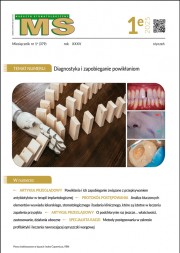Dostęp do tego artykułu jest płatny.
Zapraszamy do zakupu!
Po dokonaniu zakupu artykuł w postaci pliku PDF prześlemy bezpośrednio pod twój adres e-mail.
Barbara Sterczała, Jolanta Saczko, Marzena Dominiak
Warunkiem prawidłowego funkcjonowania kompleksu śluzówkowo-dziąsłowego jest właściwa szerokość i grubość dziąsła zrogowaciałego. Ułatwia ona kontrolę poziomu płytki nazębnej, zapobiegając powstawaniu periodontopatii zapalnych, stanowi swoistego rodzaju amortyzator dla mikro- i makrourazów dziąsła brzeżnego, zapobiegając powstaniu recesji przyzębia.
The protocol consisted of: 1. preparation of the patient for tissue biopsy, 2. biopsy of corneal gingival tissue, 3. laboratory tissue culture, 4. surgical procedure for propagated cells in place of the recipient, 5. postoperative procedure. In the operated area, the height (RD) and width (RW) of the gum recession, the width of the gingival epithelium (HKT) and thickness (TKT), the depth of the gingival pocket (PD) were assessed each time.
Results. Reduced RD on average by 2.25 mm and RW on average 1.5 mm. There was an increase in HKT on average by 1.25 mm and TKT on average by 0.6 mm and PD on average by 0.8 mm. Improved postoperative aesthetics has been demonstrated, as well as minimization of pain after surgery.
PIŚMIENNICTWO
1.Yared K.F., Zenobio E.G., Pacheco W.: Periodontal status of mandibular central incisor after orthodontic proclination in adult. Am. J. Orthod., 2006,130,1, 6:e1-8.
2. Kao R.T., Fagan M.C., Conte G.J.: Thick vs. thin gingival biotypes: a key determinant in treatment planning for dental implants. J. Calif. Dent. Assoc., 2008, 36, 3, 193-198.
3. Melsen B., Allais D.: Factors of importance for the development of dehiscences during labial movement of mandibular incisors: a retrospective study of adult orthodontic patients. Am. J. Orthod. Dentofacial Orthop., 2005, 127, 5, 552-561.
4. Proceedings of the World Workshop in Periodontics: Consensus report on mucogingival therapy. Ann. Periodontol., 1996, 1, 702-706.
5. Agudio G. i wsp.: Periodontal conditions of sites treated with gingival-augmentation surgery compared to untreated contralateral homologous sites: a 10- to 27-year long-term study. J. Periodontol., 2009, 80, 9,1399-1405.
6. Aroca S. i wsp.: Treatment of multiple adjacent Miller class I and II gingival recession with a Modified Coronally Advanced Tunnel (MCAT) technique and collage matrix or palatal connective tissue graft: a randomized, controlled clinical trial. J. Clin. Periodontol., 2013, 40, 713-720.
7. Zucchelli G. i wsp.: Coronally advanced flap with and without connective tissue graft for the treatment of multiple gingival recessions: a comparative short- and long-term controlled randomized clinical trial. J. Clin. Periodontol., 2014, 41, 396-403.
8. Zucchelli G., De Sanctis M.: Long-term outcome following treatment of multiple Miller class I and II recession defects in esthetic areas of the mouth. J. Periodontol., 2005, 76, 12, 2286-2292.
9. Wennstrom J.L. Zucchelli G.: Increased gingival dimensions. A significant factor for successful outcome of root coverage procedures? J. Clin. Periodontol.,1996, 23, 8,770-777.
10. Fletcher P. i wsp.: Cyst in alveolar mucosa adjacent to a dental implant following connective tissue grafting for ridge augmentation. Clin. Adv. Periodontics, 2011, 1, 34-39.
11. Fickl S. i wsp.: Early wound healing and patient morbidity after single-incision vs. trap-door graft harvesting from the palate – a clinical study. Clin. Oral Invest., 2014, 18, 2213-2219.
12. Karring T., Lang N.P., Löe H.: The role of gingival connective tissue in determining epithelial differentiation. J. Periodontol.,1978, 10, 1, 1-11.
13. Pini Prato G.P. i wsp.: Tissue engineering technology for gingival augmentation procedures: a case report. Int. J. Periodontics Restorative Dent., 2000, 20, 6, 552-559.
14. Lee J. i wsp.: Periodontal regeneration: focus on growth and differentiation factors. Dent. Clin. N. Am., 2010, 54, 1, 93-111.
15. Dembowska E.: Periodontologia współczesna. W: Periodontologiczna chirurgia plastyczna. Red.: Górska R. i Konopka T., Med Tour Press International Sp. z o.o., Otwock 2013, 373-420.
16. Saczko J. i wsp.: A simple and established method of tissue culture of human gingival fibroblasts for gingival augmentation. Folia Histochemica et Cytobiologica. 2008, 46, 1 ,117-119.
17. Dominiak M., Żurek J.: Uwodnione substytuty tkanki łącznej w pokrywaniu mnogich recesji dziąsła – opis przypadków. e-Dentico, 2016, 3, 61, 42-54.
18. Dominiak M. i wsp.: Use of primary culture of human fibroblasts in gingiva augmentation procedure. Biomed. Tech. (Berl), 2010, 55, 6, 331-334.
19. De Sanctis M. i wsp.: Coronally advanced flap: a modified surgical approach for isolated recession type defects. 3-year results. J. Clin. Periodontol., 2007, 34, 262-268.
20. Dominiak M. i wsp.: The clinical efficacy of primary culture of human fibroblasts in gingival augmentation procedures – a preliminary report. Ann. Anat., 2012, 194, 6, 502-507.
21. Petrungaro P.S.: Using platelet-rich plasma to accelerate soft tissue maturation in esthetic periodontal surgery. Compend. Contin. Educ. Dent., 2001, 22, 729-732.
22. Dominiak M., Mierzwa-Dudek D., Konopka T.: Connective tissue grafts with polypeptide growth factors in the treatment of multiple gingiva recession. A preliminary report. Czas. Stomatol., 2005, 58, 9, 644-651.
23. Żurek J. i wsp.: The use of biostatic fescia lata high allograft as a scaffold for autologous culture of fibroblast-An in vitro study. Ann. Anatomy 199, 2015, 104-108.
24. Chaussain Miller i wsp.: Human dermal and gingival fibroblastsin a three-dimensional culture: a comparative study on matrix remodeling. Clin. Oral Invest., 2002, 6, 39-50.
25.Yu H.C. i wsp.: Effects of fibroblast growth factor-2 on cell proliferation of cementoblasts. Journal Dental Sciences, 2016, 11, 4, 463-467.
26. Dominiak M, i wsp.: Clinical evaluation of the effectiveness of using a collagen matrix (Mucograft® prototype) in gingival recession coverage – pilot study. J. Stoma 2012; 65, 2: 184-197.
27. Allen E.P.: Subpapillary continuous sling suturing method for soft tissue grafting with the tunneling technique. Int. J. Periodontics Restorative Dent., 2010, 30, 5, 479-485.
28. Bednarz W.: The thickness of periodontal soft tissue ultrasonic examination – curent possibilities and perspectives. Dent. Med. Probl., 2011, 48, 3, 303-310.
29. Bednarz W.: Nowe możliwości diagnostyczne tkanek przyzębia przy zastosowaniu biomaterii ultradźwiękowej. e-Dentico, 2016,1, 59, 48-61.
30. Mandelaris G.A. i wsp.: A classification system for crestal and radicular dentoalveolar bone phenotypes. Int. J. Periodontics Restorative Dent., 2013, 33, 3, 289-296.














